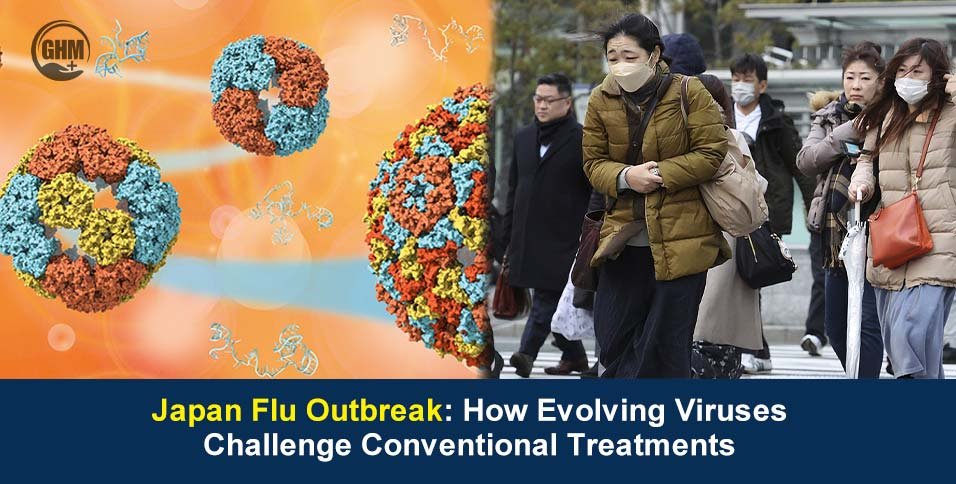Japan is in the grip of an early flu epidemic, with health authorities reporting a nationwide surge in influenza infections. The Japan Flu Outbreak began nearly five weeks earlier than usual, triggering renewed concerns over the evolving nature of influenza viruses and their growing ability to evade conventional treatments.
More than 6,000 cases have already been confirmed in hospitals and clinics across Japan, leading officials to declare a nationwide influenza epidemic. The sharp rise in cases is accompanied by a worrying scientific trend of faster viral mutation rates and potential reduced sensitivity to existing antivirals and vaccines.
Understanding the 2025 Japan Flu Outbreak
This year’s flu season in Japan arrived far ahead of schedule. Typically, influenza activity peaks between late November and early February. However, by early October 2025, flu cases were already surging in schools, workplaces, and hospitals.
According to the Japanese National Institute of Infectious Diseases (NIID), the speed of transmission has been unusually high, putting pressure on healthcare systems and raising questions about the nature of the virus driving this outbreak.
Unlike seasonal waves of the past, this outbreak is being closely monitored for signs of virus evolution. It is a process in which influenza strains change their genetic makeup, making them harder to predict and treat effectively.
Why Virus Evolution Matters More Than Ever
Influenza viruses are known for their rapid mutation rates, particularly through a process called antigenic drift. This natural genetic change can alter the virus’s surface proteins, which are the main targets of flu vaccines and antiviral drugs.
The Japan Flu Outbreak raises concerns that these mutations may reduce the effectiveness of current treatments. Even a small change in viral structure can mean the difference between a mild flu season and a severe epidemic.
“Influenza is a master of adaptation. When mutation rates accelerate, our standard tools, vaccines and antivirals can quickly lose their edge,” said one infectious disease researcher in Tokyo.
This growing evolutionary pressure on the virus may be a result of,
- Global travel
- Environmental factors
- Changing immunity patterns
- Increased viral circulation post-pandemic.
Early Indicators: Signs of Reduced Antiviral Effectiveness
Japan’s health authorities have flagged potential signs of reduced response to common antiviral medications, which are usually prescribed to shorten flu duration and reduce complications.
While data is still emerging, researchers have observed:
- Delayed recovery times in some patients treated with standard antivirals.
- Higher viral loads, suggesting more aggressive viral replication.
- Clusters of cases where transmission continued despite early treatment.
These findings do not confirm full drug resistance but highlight the need for close monitoring of antiviral performance as the outbreak unfolds.
Vaccine Mismatch: Virus Changes Faster Than the Shot
- Every year, flu vaccines are designed based on predicted circulating strains. But when viruses evolve faster than expected, there’s a risk of a vaccine mismatch, where the vaccine provides lower protection.
- Experts are warning that this Japan Flu Outbreak could be a case where the dominant strain is slightly different from what the vaccine was formulated to target.
- Even small mismatches can reduce effectiveness, particularly among elderly adults, young children, and people with chronic health conditions.
Public health officials are now urging early vaccination regardless, emphasising that even partial protection can help prevent severe illness and slow transmission.
A New Era of Flu: Rising Mutation Rates
Researchers are investigating why mutation rates may be accelerating. Several factors are under consideration:
- Viral competition and recombination: Multiple flu strains co-circulating can swap genetic material.
- Global mobility: Faster travel spreads diverse strains, increasing evolutionary pressure.
- Post-pandemic immunity gaps: Fewer exposures during COVID-19 may have left populations more vulnerable.
- Climate and seasonal shifts: Warmer, unpredictable weather patterns may be affecting flu seasonality.
The Japan Flu Epidemic may be an early example of how influenza viruses adapt to a changing world.
Future of Flu Prevention and Therapy
As virus evolution accelerates, experts say we must adapt our prevention and treatment strategies just as quickly.
Several key responses are being explored:
1. Next-Generation Vaccines
- Development of universal flu vaccines that target parts of the virus less likely to mutate.
- More flexible vaccine production platforms to allow faster updates.
2. Enhanced Surveillance Systems
- Real-time genetic tracking to detect new variants early.
- International data sharing to improve prediction models.
3. New Antivirals and Combination Therapies
- Research into broad-spectrum antivirals.
- Combination treatments that reduce the chance of resistance.
4. Public Health Measures
- Earlier vaccination campaigns, especially for high-risk groups
- Clear communication about mask use, hygiene, and symptom monitoring during outbreaks.
Global Implications of the Japan Flu Outbreak
Although the epidemic is currently centered in Japan, experts warn that influenza spreads rapidly across borders. Early viral evolution in one country can shape global flu patterns for the entire season.
The Japan Flu Outbreak offers a crucial early warning that if viral mutation continues at this pace, current seasonal strategies may not be enough.
This situation underscores the importance of global coordination, investment in new technologies, and public health preparedness.
Conclusion
The Japan Flu Outbreak is more than a seasonal surge; it’s a signal of how fast influenza viruses can change. Conventional treatments, from antivirals to vaccines, are facing new challenges.
As researchers race to understand these evolving influenza viruses, health systems around the world must be ready to adapt and respond quickly.
These influenza viruses could reshape how the world prepares for and treats flu epidemics. The Japan Flu Outbreak is a reminder that virus evolution isn’t just a scientific concept, but it’s a public health reality.
For now, early vaccination, good hygiene, and rapid detection remain our strongest tools against an unpredictable enemy.



















